Corporate Accounting & Reporting: CGU & Goodwill Impairment Loss
VerifiedAdded on 2023/06/16
|8
|1328
|317
Report
AI Summary
This report provides a detailed analysis of impairment loss in corporate accounting and reporting, focusing on the application of IAS 36 and the specific considerations for Cash Generating Units (CGUs) including goodwill. It addresses the recognition, measurement, and allocation of impairment losses, particularly in the context of CGUs. The report includes a solution to a specific question involving Gali Limited's fine China division, demonstrating the step-by-step process of calculating and allocating impairment losses across various assets, including plant, equipment, fittings, inventory, and goodwill. The analysis emphasizes the importance of accurate valuation and the proper disclosure of management's estimates and assumptions in financial statements. The report concludes by summarizing the key considerations for impairment assessment and disclosure requirements.

CORPORATE
ACCOUNTING &
REPORTING
ASSIGNMENT
ACCOUNTING &
REPORTING
ASSIGNMENT
Paraphrase This Document
Need a fresh take? Get an instant paraphrase of this document with our AI Paraphraser
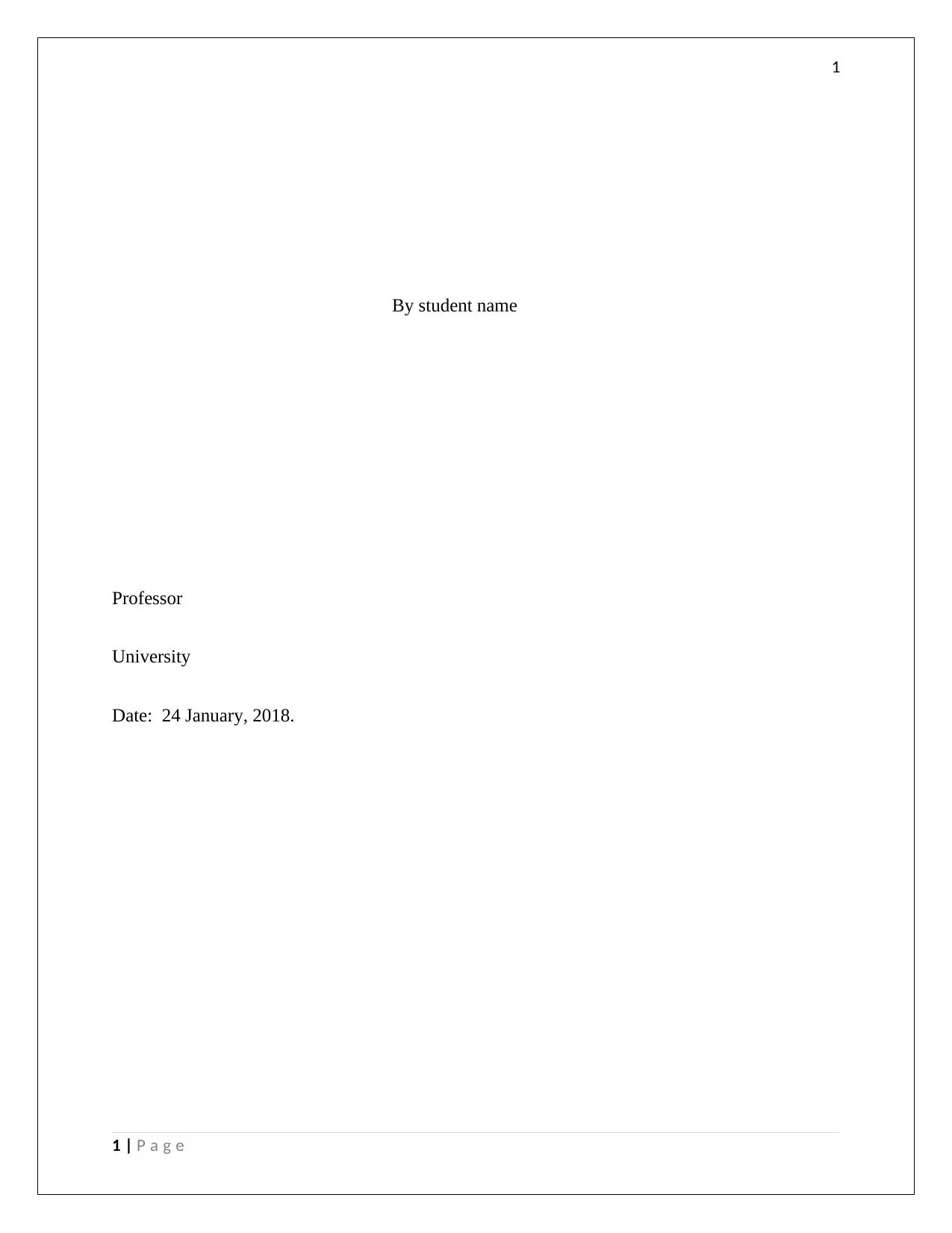
1
By student name
Professor
University
Date: 24 January, 2018.
1 | P a g e
By student name
Professor
University
Date: 24 January, 2018.
1 | P a g e
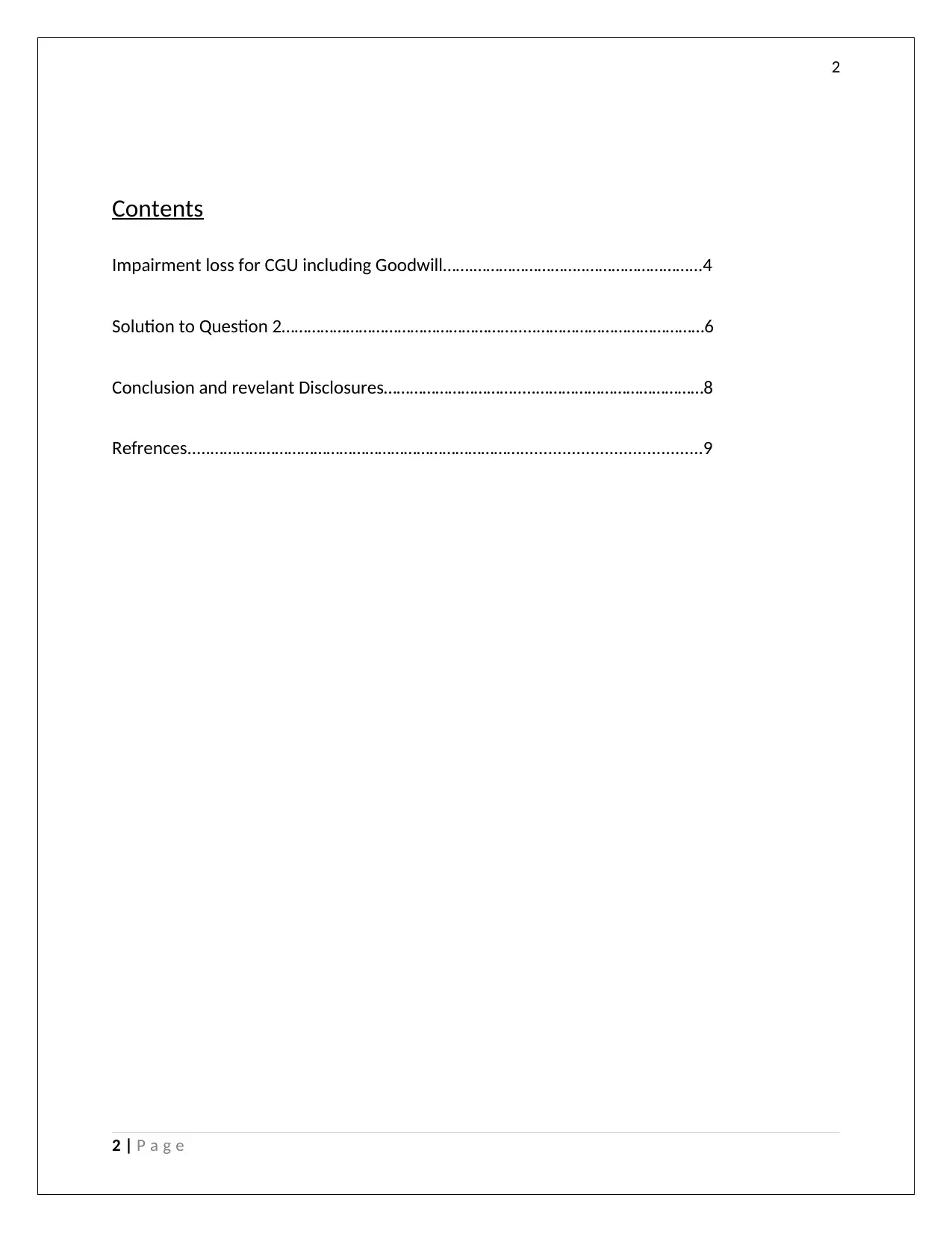
2
Contents
Impairment loss for CGU including Goodwill…….……………………..……………………...4
Solution to Question 2……………………………………………….....…………………………………6
Conclusion and revelant Disclosures………………………….....…………………………………8
Refrences.....……………………………………………………………….......................................9
2 | P a g e
Contents
Impairment loss for CGU including Goodwill…….……………………..……………………...4
Solution to Question 2……………………………………………….....…………………………………6
Conclusion and revelant Disclosures………………………….....…………………………………8
Refrences.....……………………………………………………………….......................................9
2 | P a g e
⊘ This is a preview!⊘
Do you want full access?
Subscribe today to unlock all pages.

Trusted by 1+ million students worldwide
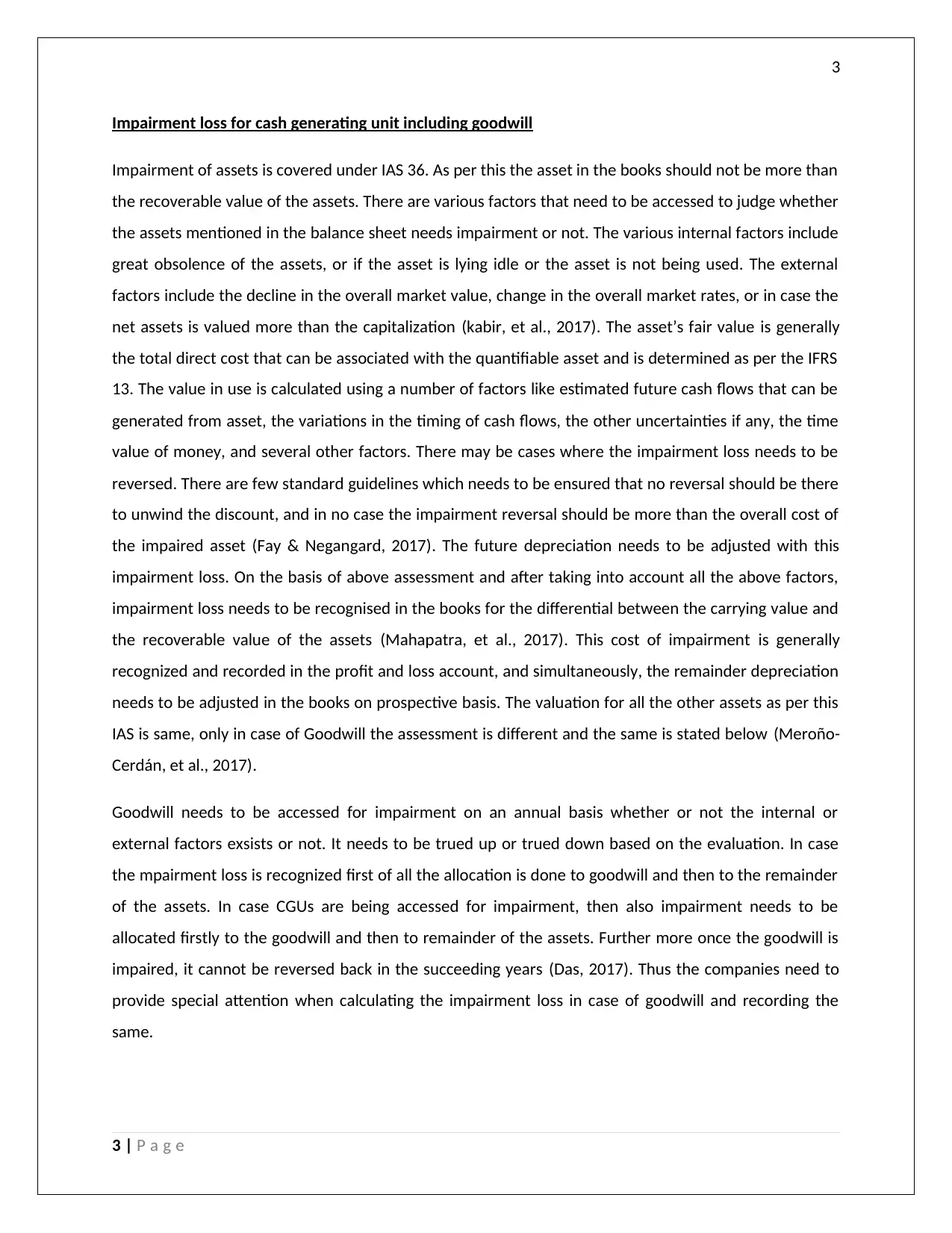
3
Impairment loss for cash generating unit including goodwill
Impairment of assets is covered under IAS 36. As per this the asset in the books should not be more than
the recoverable value of the assets. There are various factors that need to be accessed to judge whether
the assets mentioned in the balance sheet needs impairment or not. The various internal factors include
great obsolence of the assets, or if the asset is lying idle or the asset is not being used. The external
factors include the decline in the overall market value, change in the overall market rates, or in case the
net assets is valued more than the capitalization (kabir, et al., 2017). The asset’s fair value is generally
the total direct cost that can be associated with the quantifiable asset and is determined as per the IFRS
13. The value in use is calculated using a number of factors like estimated future cash flows that can be
generated from asset, the variations in the timing of cash flows, the other uncertainties if any, the time
value of money, and several other factors. There may be cases where the impairment loss needs to be
reversed. There are few standard guidelines which needs to be ensured that no reversal should be there
to unwind the discount, and in no case the impairment reversal should be more than the overall cost of
the impaired asset (Fay & Negangard, 2017). The future depreciation needs to be adjusted with this
impairment loss. On the basis of above assessment and after taking into account all the above factors,
impairment loss needs to be recognised in the books for the differential between the carrying value and
the recoverable value of the assets (Mahapatra, et al., 2017). This cost of impairment is generally
recognized and recorded in the profit and loss account, and simultaneously, the remainder depreciation
needs to be adjusted in the books on prospective basis. The valuation for all the other assets as per this
IAS is same, only in case of Goodwill the assessment is different and the same is stated below (Meroño-
Cerdán, et al., 2017).
Goodwill needs to be accessed for impairment on an annual basis whether or not the internal or
external factors exsists or not. It needs to be trued up or trued down based on the evaluation. In case
the mpairment loss is recognized first of all the allocation is done to goodwill and then to the remainder
of the assets. In case CGUs are being accessed for impairment, then also impairment needs to be
allocated firstly to the goodwill and then to remainder of the assets. Further more once the goodwill is
impaired, it cannot be reversed back in the succeeding years (Das, 2017). Thus the companies need to
provide special attention when calculating the impairment loss in case of goodwill and recording the
same.
3 | P a g e
Impairment loss for cash generating unit including goodwill
Impairment of assets is covered under IAS 36. As per this the asset in the books should not be more than
the recoverable value of the assets. There are various factors that need to be accessed to judge whether
the assets mentioned in the balance sheet needs impairment or not. The various internal factors include
great obsolence of the assets, or if the asset is lying idle or the asset is not being used. The external
factors include the decline in the overall market value, change in the overall market rates, or in case the
net assets is valued more than the capitalization (kabir, et al., 2017). The asset’s fair value is generally
the total direct cost that can be associated with the quantifiable asset and is determined as per the IFRS
13. The value in use is calculated using a number of factors like estimated future cash flows that can be
generated from asset, the variations in the timing of cash flows, the other uncertainties if any, the time
value of money, and several other factors. There may be cases where the impairment loss needs to be
reversed. There are few standard guidelines which needs to be ensured that no reversal should be there
to unwind the discount, and in no case the impairment reversal should be more than the overall cost of
the impaired asset (Fay & Negangard, 2017). The future depreciation needs to be adjusted with this
impairment loss. On the basis of above assessment and after taking into account all the above factors,
impairment loss needs to be recognised in the books for the differential between the carrying value and
the recoverable value of the assets (Mahapatra, et al., 2017). This cost of impairment is generally
recognized and recorded in the profit and loss account, and simultaneously, the remainder depreciation
needs to be adjusted in the books on prospective basis. The valuation for all the other assets as per this
IAS is same, only in case of Goodwill the assessment is different and the same is stated below (Meroño-
Cerdán, et al., 2017).
Goodwill needs to be accessed for impairment on an annual basis whether or not the internal or
external factors exsists or not. It needs to be trued up or trued down based on the evaluation. In case
the mpairment loss is recognized first of all the allocation is done to goodwill and then to the remainder
of the assets. In case CGUs are being accessed for impairment, then also impairment needs to be
allocated firstly to the goodwill and then to remainder of the assets. Further more once the goodwill is
impaired, it cannot be reversed back in the succeeding years (Das, 2017). Thus the companies need to
provide special attention when calculating the impairment loss in case of goodwill and recording the
same.
3 | P a g e
Paraphrase This Document
Need a fresh take? Get an instant paraphrase of this document with our AI Paraphraser
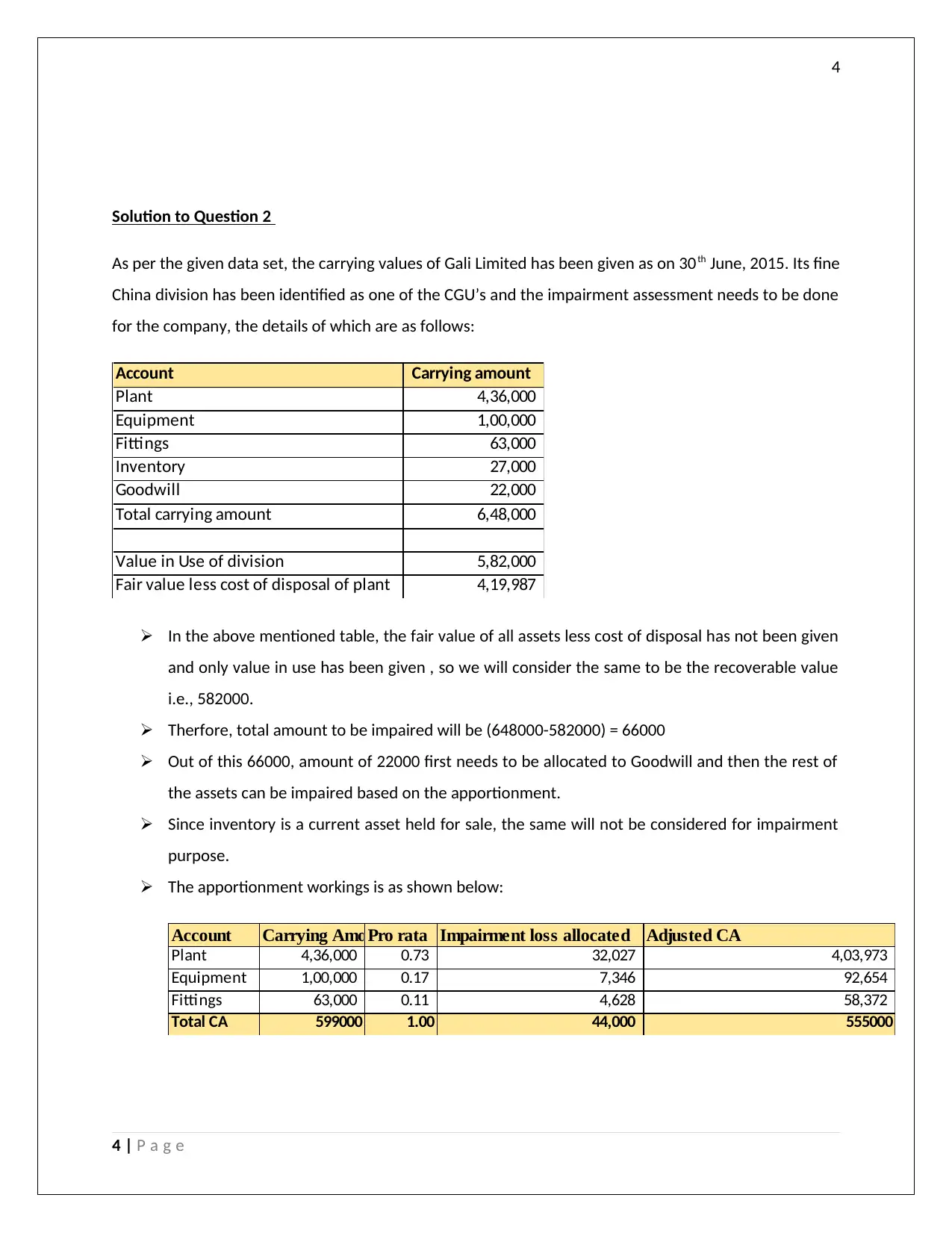
4
Solution to Question 2
As per the given data set, the carrying values of Gali Limited has been given as on 30th June, 2015. Its fine
China division has been identified as one of the CGU’s and the impairment assessment needs to be done
for the company, the details of which are as follows:
Account Carrying amount
Plant 4,36,000
Equipment 1,00,000
Fittings 63,000
Inventory 27,000
Goodwill 22,000
Total carrying amount 6,48,000
Value in Use of division 5,82,000
Fair value less cost of disposal of plant 4,19,987
In the above mentioned table, the fair value of all assets less cost of disposal has not been given
and only value in use has been given , so we will consider the same to be the recoverable value
i.e., 582000.
Therfore, total amount to be impaired will be (648000-582000) = 66000
Out of this 66000, amount of 22000 first needs to be allocated to Goodwill and then the rest of
the assets can be impaired based on the apportionment.
Since inventory is a current asset held for sale, the same will not be considered for impairment
purpose.
The apportionment workings is as shown below:
Account Carrying AmountPro rata Impairment loss allocated Adjusted CA
Plant 4,36,000 0.73 32,027 4,03,973
Equipment 1,00,000 0.17 7,346 92,654
Fittings 63,000 0.11 4,628 58,372
Total CA 599000 1.00 44,000 555000
4 | P a g e
Solution to Question 2
As per the given data set, the carrying values of Gali Limited has been given as on 30th June, 2015. Its fine
China division has been identified as one of the CGU’s and the impairment assessment needs to be done
for the company, the details of which are as follows:
Account Carrying amount
Plant 4,36,000
Equipment 1,00,000
Fittings 63,000
Inventory 27,000
Goodwill 22,000
Total carrying amount 6,48,000
Value in Use of division 5,82,000
Fair value less cost of disposal of plant 4,19,987
In the above mentioned table, the fair value of all assets less cost of disposal has not been given
and only value in use has been given , so we will consider the same to be the recoverable value
i.e., 582000.
Therfore, total amount to be impaired will be (648000-582000) = 66000
Out of this 66000, amount of 22000 first needs to be allocated to Goodwill and then the rest of
the assets can be impaired based on the apportionment.
Since inventory is a current asset held for sale, the same will not be considered for impairment
purpose.
The apportionment workings is as shown below:
Account Carrying AmountPro rata Impairment loss allocated Adjusted CA
Plant 4,36,000 0.73 32,027 4,03,973
Equipment 1,00,000 0.17 7,346 92,654
Fittings 63,000 0.11 4,628 58,372
Total CA 599000 1.00 44,000 555000
4 | P a g e
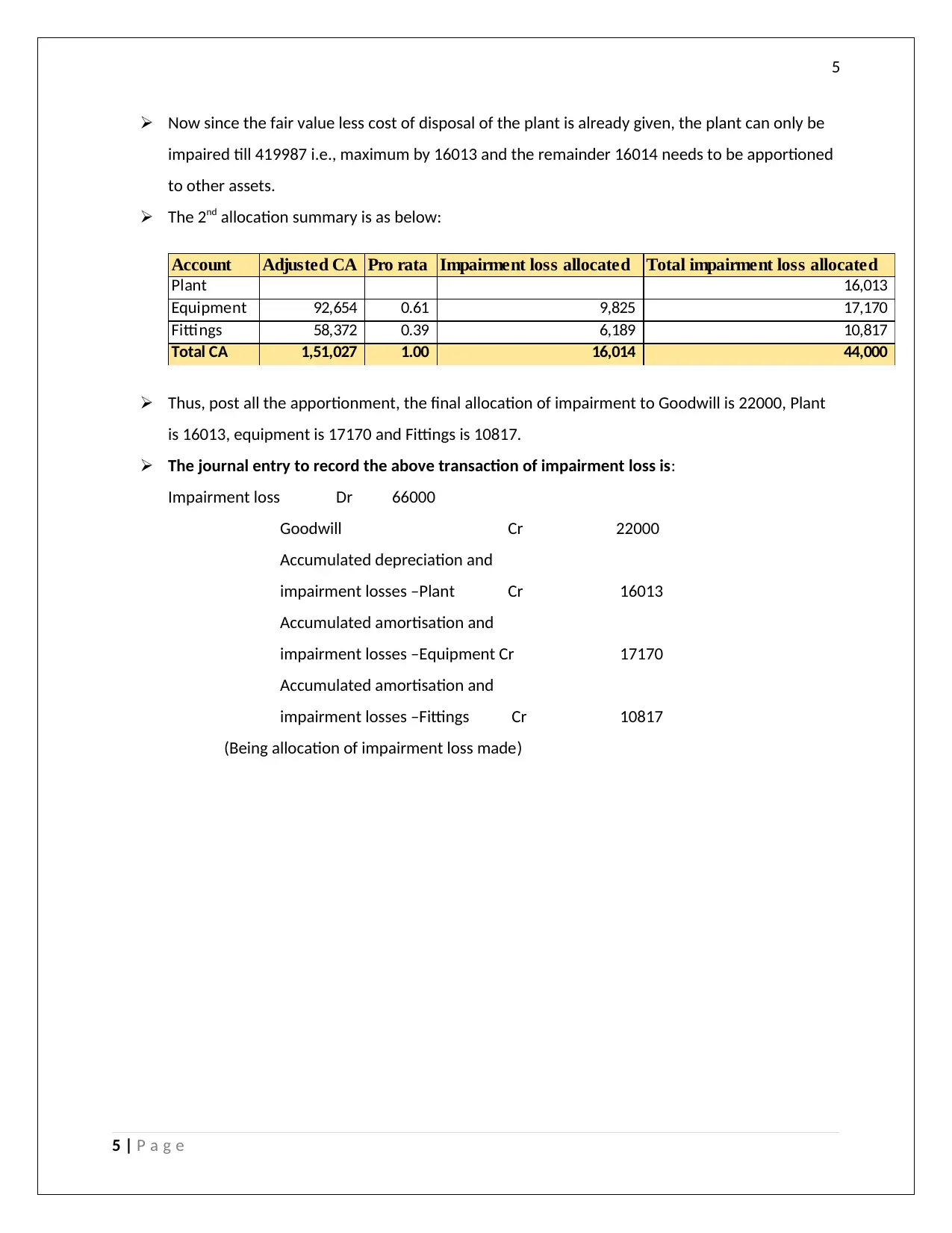
5
Now since the fair value less cost of disposal of the plant is already given, the plant can only be
impaired till 419987 i.e., maximum by 16013 and the remainder 16014 needs to be apportioned
to other assets.
The 2nd allocation summary is as below:
Account Adjusted CA Pro rata Impairment loss allocated Total impairment loss allocated
Plant 16,013
Equipment 92,654 0.61 9,825 17,170
Fittings 58,372 0.39 6,189 10,817
Total CA 1,51,027 1.00 16,014 44,000
Thus, post all the apportionment, the final allocation of impairment to Goodwill is 22000, Plant
is 16013, equipment is 17170 and Fittings is 10817.
The journal entry to record the above transaction of impairment loss is:
Impairment loss Dr 66000
Goodwill Cr 22000
Accumulated depreciation and
impairment losses –Plant Cr 16013
Accumulated amortisation and
impairment losses –Equipment Cr 17170
Accumulated amortisation and
impairment losses –Fittings Cr 10817
(Being allocation of impairment loss made)
5 | P a g e
Now since the fair value less cost of disposal of the plant is already given, the plant can only be
impaired till 419987 i.e., maximum by 16013 and the remainder 16014 needs to be apportioned
to other assets.
The 2nd allocation summary is as below:
Account Adjusted CA Pro rata Impairment loss allocated Total impairment loss allocated
Plant 16,013
Equipment 92,654 0.61 9,825 17,170
Fittings 58,372 0.39 6,189 10,817
Total CA 1,51,027 1.00 16,014 44,000
Thus, post all the apportionment, the final allocation of impairment to Goodwill is 22000, Plant
is 16013, equipment is 17170 and Fittings is 10817.
The journal entry to record the above transaction of impairment loss is:
Impairment loss Dr 66000
Goodwill Cr 22000
Accumulated depreciation and
impairment losses –Plant Cr 16013
Accumulated amortisation and
impairment losses –Equipment Cr 17170
Accumulated amortisation and
impairment losses –Fittings Cr 10817
(Being allocation of impairment loss made)
5 | P a g e
⊘ This is a preview!⊘
Do you want full access?
Subscribe today to unlock all pages.

Trusted by 1+ million students worldwide
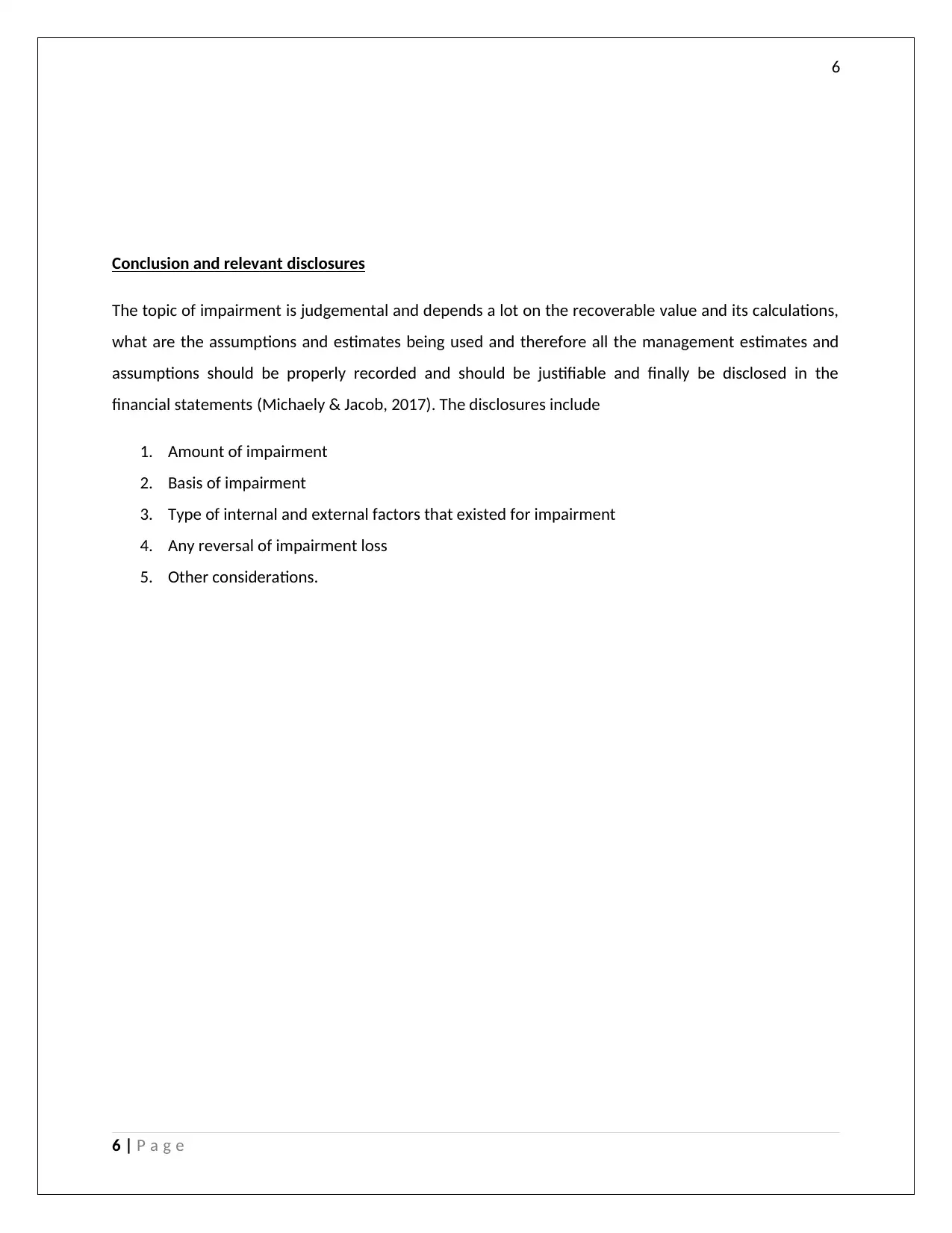
6
Conclusion and relevant disclosures
The topic of impairment is judgemental and depends a lot on the recoverable value and its calculations,
what are the assumptions and estimates being used and therefore all the management estimates and
assumptions should be properly recorded and should be justifiable and finally be disclosed in the
financial statements (Michaely & Jacob, 2017). The disclosures include
1. Amount of impairment
2. Basis of impairment
3. Type of internal and external factors that existed for impairment
4. Any reversal of impairment loss
5. Other considerations.
6 | P a g e
Conclusion and relevant disclosures
The topic of impairment is judgemental and depends a lot on the recoverable value and its calculations,
what are the assumptions and estimates being used and therefore all the management estimates and
assumptions should be properly recorded and should be justifiable and finally be disclosed in the
financial statements (Michaely & Jacob, 2017). The disclosures include
1. Amount of impairment
2. Basis of impairment
3. Type of internal and external factors that existed for impairment
4. Any reversal of impairment loss
5. Other considerations.
6 | P a g e
Paraphrase This Document
Need a fresh take? Get an instant paraphrase of this document with our AI Paraphraser

7
References
Das, P., 2017. Financing Pattern and Utilization of Fixed Assets - A Study. Asian Journal of Social Science
Studies, 2(2), pp. 10-17.
Fay, R. & Negangard, E., 2017. Manual journal entry testing : Data analytics and the risk of fraud. Journal
of Accounting Education, Volume 38, pp. 37-49.
kabir, H., Rahman, A. & Su, L., 2017. The Association between Goodwill Impairment Loss and Goodwill
Impairment Test-Related Disclosures in Australia. 8th Conference on Financial Markets and Corporate
Governance (FMCG) 2017, pp. 1-32.
Mahapatra, S., Levental, S. & Narasimhan, R., 2017. Market price uncertainty, risk aversion and
procurement: Combining contracts and open market sourcing alternatives. International Journal of
Production Economics, pp. 34-51.
Meroño-Cerdán, A., Lopez-Nicolas, C. & Molina-Castillo, F., 2017. Risk aversion, innovation and
performance in family firms. Economics of Innovation and new technology, pp. 1-15.
Michaely, R. & Jacob, M., 2017. Taxation and Dividend Policy: The Muting Effect of Agency Issues and
Shareholder Conflicts. Review of Financial Studies, 30(9), pp. 3176-3222.
7 | P a g e
References
Das, P., 2017. Financing Pattern and Utilization of Fixed Assets - A Study. Asian Journal of Social Science
Studies, 2(2), pp. 10-17.
Fay, R. & Negangard, E., 2017. Manual journal entry testing : Data analytics and the risk of fraud. Journal
of Accounting Education, Volume 38, pp. 37-49.
kabir, H., Rahman, A. & Su, L., 2017. The Association between Goodwill Impairment Loss and Goodwill
Impairment Test-Related Disclosures in Australia. 8th Conference on Financial Markets and Corporate
Governance (FMCG) 2017, pp. 1-32.
Mahapatra, S., Levental, S. & Narasimhan, R., 2017. Market price uncertainty, risk aversion and
procurement: Combining contracts and open market sourcing alternatives. International Journal of
Production Economics, pp. 34-51.
Meroño-Cerdán, A., Lopez-Nicolas, C. & Molina-Castillo, F., 2017. Risk aversion, innovation and
performance in family firms. Economics of Innovation and new technology, pp. 1-15.
Michaely, R. & Jacob, M., 2017. Taxation and Dividend Policy: The Muting Effect of Agency Issues and
Shareholder Conflicts. Review of Financial Studies, 30(9), pp. 3176-3222.
7 | P a g e
1 out of 8
Related Documents
Your All-in-One AI-Powered Toolkit for Academic Success.
+13062052269
info@desklib.com
Available 24*7 on WhatsApp / Email
![[object Object]](/_next/static/media/star-bottom.7253800d.svg)
Unlock your academic potential
Copyright © 2020–2025 A2Z Services. All Rights Reserved. Developed and managed by ZUCOL.




